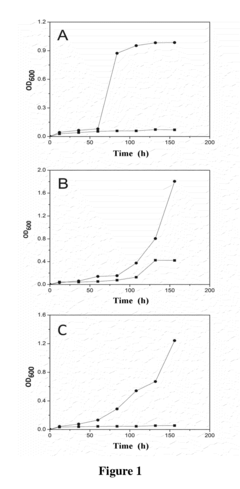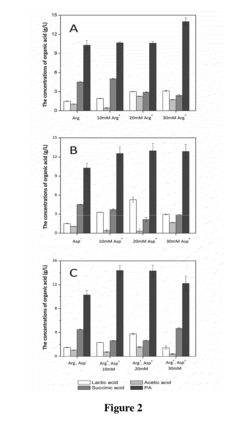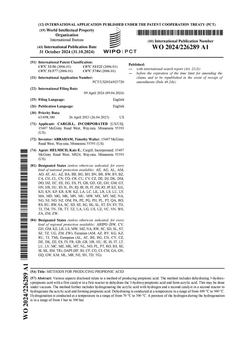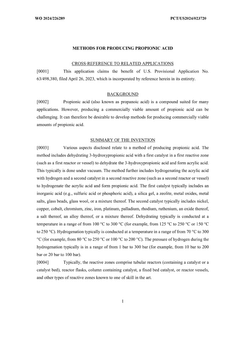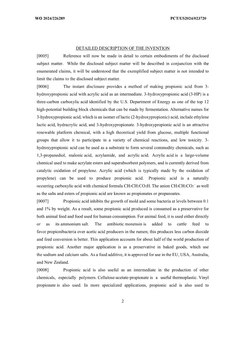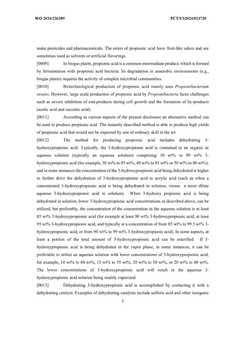How to Approach Propionic Acid in Advanced Chemical Studies?
JUL 3, 20259 MIN READ
Generate Your Research Report Instantly with AI Agent
Patsnap Eureka helps you evaluate technical feasibility & market potential.
Propionic Acid Research Background and Objectives
Propionic acid, a three-carbon carboxylic acid, has been a subject of significant interest in advanced chemical studies due to its versatile applications and unique properties. The evolution of research in this field has been driven by the increasing demand for sustainable and efficient chemical processes across various industries.
The journey of propionic acid research can be traced back to its discovery in the mid-19th century. Initially, it was primarily studied for its occurrence in natural processes, such as bacterial fermentation. However, as industrial chemistry advanced, the focus shifted towards understanding its synthesis, properties, and potential applications.
In recent decades, the objectives of propionic acid research have expanded significantly. One primary goal is to develop more efficient and environmentally friendly production methods. Traditional petrochemical-based processes are being challenged by bio-based production routes, which aim to utilize renewable resources and reduce carbon footprint.
Another key objective is to explore novel applications of propionic acid beyond its conventional uses. Researchers are investigating its potential in areas such as biodegradable polymers, pharmaceuticals, and advanced materials. This diversification of applications is driving the need for a deeper understanding of propionic acid's chemical behavior and reactivity.
The study of propionic acid also intersects with broader scientific trends, such as green chemistry and circular economy principles. Researchers are focusing on developing closed-loop systems where propionic acid can be efficiently produced, utilized, and recycled, minimizing waste and environmental impact.
Advanced analytical techniques have become crucial in propionic acid research. High-resolution spectroscopy, computational chemistry, and in-situ monitoring methods are being employed to gain insights into reaction mechanisms and molecular interactions involving propionic acid. These tools are essential for optimizing processes and developing new applications.
The global nature of chemical research has led to collaborative efforts in propionic acid studies. International research teams are working together to address challenges such as improving catalytic systems for propionic acid synthesis, enhancing its purification methods, and exploring its role in complex chemical systems.
As we look towards the future, the objectives of propionic acid research are likely to evolve further. Emerging fields such as nanotechnology and bioengineering may open up new avenues for propionic acid applications. Additionally, the integration of artificial intelligence and machine learning in chemical research is expected to accelerate discoveries and optimizations in propionic acid studies.
The journey of propionic acid research can be traced back to its discovery in the mid-19th century. Initially, it was primarily studied for its occurrence in natural processes, such as bacterial fermentation. However, as industrial chemistry advanced, the focus shifted towards understanding its synthesis, properties, and potential applications.
In recent decades, the objectives of propionic acid research have expanded significantly. One primary goal is to develop more efficient and environmentally friendly production methods. Traditional petrochemical-based processes are being challenged by bio-based production routes, which aim to utilize renewable resources and reduce carbon footprint.
Another key objective is to explore novel applications of propionic acid beyond its conventional uses. Researchers are investigating its potential in areas such as biodegradable polymers, pharmaceuticals, and advanced materials. This diversification of applications is driving the need for a deeper understanding of propionic acid's chemical behavior and reactivity.
The study of propionic acid also intersects with broader scientific trends, such as green chemistry and circular economy principles. Researchers are focusing on developing closed-loop systems where propionic acid can be efficiently produced, utilized, and recycled, minimizing waste and environmental impact.
Advanced analytical techniques have become crucial in propionic acid research. High-resolution spectroscopy, computational chemistry, and in-situ monitoring methods are being employed to gain insights into reaction mechanisms and molecular interactions involving propionic acid. These tools are essential for optimizing processes and developing new applications.
The global nature of chemical research has led to collaborative efforts in propionic acid studies. International research teams are working together to address challenges such as improving catalytic systems for propionic acid synthesis, enhancing its purification methods, and exploring its role in complex chemical systems.
As we look towards the future, the objectives of propionic acid research are likely to evolve further. Emerging fields such as nanotechnology and bioengineering may open up new avenues for propionic acid applications. Additionally, the integration of artificial intelligence and machine learning in chemical research is expected to accelerate discoveries and optimizations in propionic acid studies.
Industrial Applications and Market Demand
Propionic acid has emerged as a versatile compound with significant industrial applications and growing market demand. The chemical's unique properties make it valuable across various sectors, driving its increasing adoption in advanced chemical studies and industrial processes.
In the food and beverage industry, propionic acid serves as a crucial preservative, particularly in baked goods and dairy products. Its ability to inhibit mold growth extends shelf life and maintains product quality, addressing consumer demands for natural preservatives. The rising trend of clean label products has further boosted the use of propionic acid as a safer alternative to synthetic preservatives.
The pharmaceutical sector represents another major application area for propionic acid. It is used as a precursor in the synthesis of various drugs and as an excipient in pharmaceutical formulations. The growing pharmaceutical industry, coupled with increased research and development activities, has contributed to the expanding market for propionic acid in this sector.
Agriculture and animal feed industries have also witnessed a surge in propionic acid demand. As a feed preservative, it prevents mold growth in animal feed, ensuring better nutrition and health for livestock. The global focus on sustainable agriculture and improved animal husbandry practices has driven the adoption of propionic acid in these applications.
The chemical industry utilizes propionic acid as a building block for various chemicals, including cellulose acetate propionate, herbicides, and plasticizers. The growing emphasis on sustainable and bio-based chemicals has further propelled the demand for propionic acid in these applications, as it can be produced through both petrochemical and bio-based routes.
Market analysis indicates a steady growth trajectory for propionic acid. The global market size is expected to expand significantly in the coming years, driven by increasing applications across diverse industries. Factors such as population growth, urbanization, and rising disposable incomes in developing economies are contributing to the increased consumption of processed foods and pharmaceuticals, indirectly boosting propionic acid demand.
Geographically, North America and Europe currently dominate the propionic acid market, owing to their well-established food and pharmaceutical industries. However, the Asia-Pacific region is emerging as a lucrative market, with rapid industrialization and changing consumer preferences driving demand growth.
The market landscape is characterized by ongoing research and development efforts aimed at expanding propionic acid applications and improving production processes. Innovations in bio-based production methods are gaining traction, aligning with the global shift towards sustainable and environmentally friendly chemical processes.
In the food and beverage industry, propionic acid serves as a crucial preservative, particularly in baked goods and dairy products. Its ability to inhibit mold growth extends shelf life and maintains product quality, addressing consumer demands for natural preservatives. The rising trend of clean label products has further boosted the use of propionic acid as a safer alternative to synthetic preservatives.
The pharmaceutical sector represents another major application area for propionic acid. It is used as a precursor in the synthesis of various drugs and as an excipient in pharmaceutical formulations. The growing pharmaceutical industry, coupled with increased research and development activities, has contributed to the expanding market for propionic acid in this sector.
Agriculture and animal feed industries have also witnessed a surge in propionic acid demand. As a feed preservative, it prevents mold growth in animal feed, ensuring better nutrition and health for livestock. The global focus on sustainable agriculture and improved animal husbandry practices has driven the adoption of propionic acid in these applications.
The chemical industry utilizes propionic acid as a building block for various chemicals, including cellulose acetate propionate, herbicides, and plasticizers. The growing emphasis on sustainable and bio-based chemicals has further propelled the demand for propionic acid in these applications, as it can be produced through both petrochemical and bio-based routes.
Market analysis indicates a steady growth trajectory for propionic acid. The global market size is expected to expand significantly in the coming years, driven by increasing applications across diverse industries. Factors such as population growth, urbanization, and rising disposable incomes in developing economies are contributing to the increased consumption of processed foods and pharmaceuticals, indirectly boosting propionic acid demand.
Geographically, North America and Europe currently dominate the propionic acid market, owing to their well-established food and pharmaceutical industries. However, the Asia-Pacific region is emerging as a lucrative market, with rapid industrialization and changing consumer preferences driving demand growth.
The market landscape is characterized by ongoing research and development efforts aimed at expanding propionic acid applications and improving production processes. Innovations in bio-based production methods are gaining traction, aligning with the global shift towards sustainable and environmentally friendly chemical processes.
Current State and Challenges in Propionic Acid Studies
Propionic acid has gained significant attention in advanced chemical studies due to its versatile applications and potential for sustainable production. The current state of research in this field is characterized by a blend of traditional approaches and innovative methodologies. Researchers are actively exploring novel synthesis routes, focusing on green chemistry principles and bio-based production methods.
One of the primary challenges in propionic acid studies is the development of more efficient and environmentally friendly production processes. While traditional petrochemical-based methods remain dominant, there is a growing emphasis on fermentation-based approaches using renewable feedstocks. However, these biological processes face hurdles in terms of yield optimization and scalability.
Another significant area of focus is the improvement of catalytic systems for propionic acid synthesis. Current research is centered on developing heterogeneous catalysts that offer higher selectivity and longer lifetimes. The quest for catalysts that can operate under milder conditions and with reduced energy input remains a key challenge.
In the realm of analytical chemistry, advancements in spectroscopic and chromatographic techniques have enhanced the ability to detect and quantify propionic acid in complex matrices. This progress is crucial for quality control in industrial applications and for environmental monitoring. However, challenges persist in developing rapid, on-site detection methods for real-time analysis.
The application of propionic acid in polymer science represents another frontier. Researchers are exploring its potential as a monomer for biodegradable plastics, but issues related to polymerization kinetics and material properties need to be addressed. The development of propionic acid-based copolymers with enhanced mechanical and thermal properties is an ongoing challenge.
In the field of pharmaceuticals and food preservation, propionic acid's antimicrobial properties are being extensively studied. While its effectiveness is well-established, current research aims to optimize its formulation for specific applications and to understand its synergistic effects with other preservatives. The challenge lies in balancing efficacy with sensory impacts, especially in food applications.
Computational studies and molecular modeling have emerged as powerful tools in propionic acid research. These approaches are being used to predict reaction mechanisms, design new catalysts, and understand the interactions of propionic acid in various systems. However, bridging the gap between theoretical predictions and experimental validation remains a significant challenge.
One of the primary challenges in propionic acid studies is the development of more efficient and environmentally friendly production processes. While traditional petrochemical-based methods remain dominant, there is a growing emphasis on fermentation-based approaches using renewable feedstocks. However, these biological processes face hurdles in terms of yield optimization and scalability.
Another significant area of focus is the improvement of catalytic systems for propionic acid synthesis. Current research is centered on developing heterogeneous catalysts that offer higher selectivity and longer lifetimes. The quest for catalysts that can operate under milder conditions and with reduced energy input remains a key challenge.
In the realm of analytical chemistry, advancements in spectroscopic and chromatographic techniques have enhanced the ability to detect and quantify propionic acid in complex matrices. This progress is crucial for quality control in industrial applications and for environmental monitoring. However, challenges persist in developing rapid, on-site detection methods for real-time analysis.
The application of propionic acid in polymer science represents another frontier. Researchers are exploring its potential as a monomer for biodegradable plastics, but issues related to polymerization kinetics and material properties need to be addressed. The development of propionic acid-based copolymers with enhanced mechanical and thermal properties is an ongoing challenge.
In the field of pharmaceuticals and food preservation, propionic acid's antimicrobial properties are being extensively studied. While its effectiveness is well-established, current research aims to optimize its formulation for specific applications and to understand its synergistic effects with other preservatives. The challenge lies in balancing efficacy with sensory impacts, especially in food applications.
Computational studies and molecular modeling have emerged as powerful tools in propionic acid research. These approaches are being used to predict reaction mechanisms, design new catalysts, and understand the interactions of propionic acid in various systems. However, bridging the gap between theoretical predictions and experimental validation remains a significant challenge.
Current Methodologies in Propionic Acid Analysis
01 Production methods of propionic acid
Various methods for producing propionic acid are described, including fermentation processes, chemical synthesis routes, and catalytic reactions. These methods aim to improve yield, efficiency, and purity of propionic acid production for industrial applications.- Production methods of propionic acid: Various methods are employed for the production of propionic acid, including fermentation processes, chemical synthesis, and catalytic reactions. These methods often involve the use of specific microorganisms, catalysts, or chemical precursors to efficiently produce propionic acid on an industrial scale.
- Applications of propionic acid in food preservation: Propionic acid is widely used as a food preservative due to its antimicrobial properties. It is effective in preventing mold growth and extending the shelf life of various food products, particularly in baked goods, dairy products, and animal feed.
- Use of propionic acid in pharmaceutical industry: Propionic acid and its derivatives find applications in the pharmaceutical industry. They are used in the synthesis of various drugs, as intermediates in the production of active pharmaceutical ingredients, and in some cases, as therapeutic agents themselves.
- Environmental and safety considerations in propionic acid handling: The handling and storage of propionic acid require specific safety measures due to its corrosive nature and potential environmental impact. Proper containment, neutralization techniques, and waste management strategies are essential for the safe use of propionic acid in industrial settings.
- Purification and quality control of propionic acid: Various purification methods and quality control measures are employed to ensure the production of high-purity propionic acid. These may include distillation techniques, chromatographic methods, and spectroscopic analysis to remove impurities and maintain consistent product quality.
02 Applications of propionic acid in food preservation
Propionic acid and its salts are widely used as food preservatives due to their antimicrobial properties. They are effective in preventing mold growth and extending the shelf life of various food products, particularly in bakery items and dairy products.Expand Specific Solutions03 Use of propionic acid in pharmaceutical formulations
Propionic acid and its derivatives find applications in pharmaceutical formulations. They are used as excipients, pH adjusters, and in some cases, as active pharmaceutical ingredients for various therapeutic purposes.Expand Specific Solutions04 Propionic acid in polymer and plastics industry
Propionic acid is utilized in the production of cellulose plastics, various polymers, and as a chemical intermediate in the synthesis of other compounds used in the plastics industry. It contributes to the development of specialized materials with unique properties.Expand Specific Solutions05 Environmental and safety considerations in propionic acid handling
The handling, storage, and disposal of propionic acid require specific safety measures due to its corrosive nature and potential environmental impact. Innovations in this area focus on developing safer handling methods, reducing environmental risks, and improving workplace safety in industries using propionic acid.Expand Specific Solutions
Key Players in Propionic Acid Industry and Academia
The propionic acid market is in a mature stage, with established players and steady growth. The global market size is estimated to be around $1.5 billion, driven by increasing demand in food preservation, pharmaceuticals, and agriculture. Technologically, the production process is well-developed, with major companies like BASF, Dow, and Eastman Chemical leading innovation. These firms, along with others like Arkema and Nippon Shokubai, are investing in research to improve production efficiency and explore new applications. Universities such as Ohio State and Nanjing Tech are contributing to advancements in propionic acid synthesis and utilization, indicating ongoing potential for technological improvements despite the market's maturity.
Nippon Shokubai Co., Ltd.
Technical Solution: Nippon Shokubai has focused on developing an electrochemical approach to propionic acid production. Their method involves the electroreduction of carbon dioxide to propionic acid using copper-based electrodes with high Faradaic efficiency[13]. This approach not only produces propionic acid but also contributes to carbon dioxide utilization, addressing environmental concerns. Nippon Shokubai has developed proprietary electrode materials and electrolyte systems that enhance selectivity towards propionic acid formation. They have also implemented advanced electrochemical cell designs, including flow cells and gas diffusion electrodes, to improve mass transfer and reaction rates[15]. Their research extends to the integration of renewable electricity sources to power the electrochemical process, further enhancing its sustainability profile[17].
Strengths: Carbon dioxide utilization, potential for integration with renewable energy, high atom economy. Weaknesses: Challenges in achieving high current densities, potential high costs of electrode materials, competition with other CO2 reduction products.
Arkema France SA
Technical Solution: Arkema France SA has developed a novel approach to propionic acid production using a gas-phase oxidation process. Their method involves the direct oxidation of propane using a vanadium-based catalyst supported on silica[8]. This one-step process offers significant advantages in terms of atom economy and feedstock availability. Arkema has also implemented advanced reactor designs, including fluidized bed reactors, to improve heat transfer and reaction efficiency. Their research extends to the development of nano-structured catalysts that offer increased surface area and improved catalytic activity[10]. Additionally, Arkema has explored the use of membrane reactors to combine reaction and separation steps, potentially reducing energy consumption in the overall process[12].
Strengths: Direct one-step process, improved atom economy, potential for lower production costs. Weaknesses: Challenges in controlling selectivity, potential for catalyst deactivation due to coke formation.
Innovative Approaches in Propionic Acid Synthesis
Method for Improving Acid tolerance of Propionibacterium acdipropionici
PatentInactiveUS20140178952A1
Innovation
- Adding arginine and/or aspartic acid to the culture medium during the cultivation of Propionibacterium acdipropionici to enhance acid tolerance and propionic acid productivity.
Methods for producing propionic acid
PatentWO2024226289A1
Innovation
- A method involving the dehydration of 3-hydroxypropionic acid to form acrylic acid using a first catalyst, followed by hydrogenation of acrylic acid to propionic acid using a second catalyst, with specific temperature and pressure conditions, and optionally using a polymerization inhibitor to prevent acrylic acid polymerization.
Environmental Impact of Propionic Acid Production
The production of propionic acid has significant environmental implications that warrant careful consideration in advanced chemical studies. The primary method of propionic acid production involves petrochemical processes, which contribute to greenhouse gas emissions and resource depletion. These processes typically rely on the oxidation of propanol or the carbonylation of ethylene, both of which are derived from fossil fuels.
One of the major environmental concerns is the release of volatile organic compounds (VOCs) during production. These emissions can lead to the formation of ground-level ozone and contribute to air pollution. Additionally, the use of catalysts in the production process, often containing heavy metals, poses risks of soil and water contamination if not properly managed and disposed of.
Water usage and wastewater generation are also significant environmental factors in propionic acid production. The process requires substantial amounts of water for cooling and separation stages, and the resulting wastewater may contain organic contaminants that require treatment before release. This places a burden on local water resources and necessitates energy-intensive wastewater treatment processes.
Energy consumption is another critical aspect of the environmental impact. The production of propionic acid is energy-intensive, particularly in the distillation and purification stages. This high energy demand often translates to increased carbon emissions, especially if the energy source is not renewable.
However, recent advancements in green chemistry are paving the way for more sustainable production methods. Biotechnological approaches, such as the use of genetically engineered microorganisms for fermentation, offer promising alternatives with potentially lower environmental footprints. These bio-based production methods can utilize renewable feedstocks, reducing dependence on fossil fuels and decreasing overall carbon emissions.
Life cycle assessments (LCAs) of propionic acid production have revealed opportunities for improvement in environmental performance. These assessments consider the entire production chain, from raw material extraction to final product distribution, and help identify hotspots for environmental impact reduction. Implementing cleaner production technologies, optimizing process efficiency, and exploring circular economy principles can significantly mitigate the environmental burden of propionic acid production.
As the demand for propionic acid continues to grow, particularly in the food and pharmaceutical industries, addressing these environmental challenges becomes increasingly important. Advanced chemical studies should focus on developing innovative, eco-friendly production methods that minimize resource consumption, reduce emissions, and enhance overall sustainability. This may include exploring novel catalysts, improving reaction selectivity, and integrating renewable energy sources into production processes.
One of the major environmental concerns is the release of volatile organic compounds (VOCs) during production. These emissions can lead to the formation of ground-level ozone and contribute to air pollution. Additionally, the use of catalysts in the production process, often containing heavy metals, poses risks of soil and water contamination if not properly managed and disposed of.
Water usage and wastewater generation are also significant environmental factors in propionic acid production. The process requires substantial amounts of water for cooling and separation stages, and the resulting wastewater may contain organic contaminants that require treatment before release. This places a burden on local water resources and necessitates energy-intensive wastewater treatment processes.
Energy consumption is another critical aspect of the environmental impact. The production of propionic acid is energy-intensive, particularly in the distillation and purification stages. This high energy demand often translates to increased carbon emissions, especially if the energy source is not renewable.
However, recent advancements in green chemistry are paving the way for more sustainable production methods. Biotechnological approaches, such as the use of genetically engineered microorganisms for fermentation, offer promising alternatives with potentially lower environmental footprints. These bio-based production methods can utilize renewable feedstocks, reducing dependence on fossil fuels and decreasing overall carbon emissions.
Life cycle assessments (LCAs) of propionic acid production have revealed opportunities for improvement in environmental performance. These assessments consider the entire production chain, from raw material extraction to final product distribution, and help identify hotspots for environmental impact reduction. Implementing cleaner production technologies, optimizing process efficiency, and exploring circular economy principles can significantly mitigate the environmental burden of propionic acid production.
As the demand for propionic acid continues to grow, particularly in the food and pharmaceutical industries, addressing these environmental challenges becomes increasingly important. Advanced chemical studies should focus on developing innovative, eco-friendly production methods that minimize resource consumption, reduce emissions, and enhance overall sustainability. This may include exploring novel catalysts, improving reaction selectivity, and integrating renewable energy sources into production processes.
Regulatory Framework for Propionic Acid Usage
The regulatory framework for propionic acid usage is a complex and evolving landscape that encompasses various aspects of its production, handling, and application. At the international level, organizations such as the World Health Organization (WHO) and the Food and Agriculture Organization (FAO) provide guidelines for the safe use of propionic acid in food preservation and animal feed. These guidelines often serve as a basis for national regulations.
In the United States, the Food and Drug Administration (FDA) regulates propionic acid as a food additive under the Federal Food, Drug, and Cosmetic Act. It is classified as Generally Recognized as Safe (GRAS) when used as a preservative in specific food products. The Environmental Protection Agency (EPA) also oversees its use in pesticides and antimicrobial applications, setting limits on residues and exposure.
The European Union has established comprehensive regulations through the European Food Safety Authority (EFSA). Propionic acid is approved as a food additive (E280) and is subject to specific purity criteria and usage limits. The Registration, Evaluation, Authorization and Restriction of Chemicals (REACH) regulation also applies to propionic acid, requiring manufacturers and importers to register the substance and provide safety data.
In the pharmaceutical industry, regulatory bodies such as the FDA and the European Medicines Agency (EMA) have established guidelines for the use of propionic acid in drug formulations. These regulations cover aspects such as impurity profiles, stability testing, and manufacturing processes.
Occupational safety regulations, such as those set by the Occupational Safety and Health Administration (OSHA) in the US, mandate specific handling procedures, exposure limits, and personal protective equipment requirements for workers dealing with propionic acid. Similar regulations exist in other countries, often aligned with the Globally Harmonized System of Classification and Labelling of Chemicals (GHS).
Environmental regulations also play a crucial role in the propionic acid regulatory framework. Many countries have implemented strict controls on emissions and waste disposal related to its production and use. For instance, the EPA regulates propionic acid under the Clean Air Act and the Clean Water Act, setting limits on air emissions and water discharges.
As research in advanced chemical studies progresses, regulatory frameworks are likely to evolve. Emerging applications of propionic acid may require new or modified regulations. Researchers and industry professionals must stay informed about these regulatory changes and actively participate in shaping future guidelines to ensure the safe and effective use of propionic acid in various fields.
In the United States, the Food and Drug Administration (FDA) regulates propionic acid as a food additive under the Federal Food, Drug, and Cosmetic Act. It is classified as Generally Recognized as Safe (GRAS) when used as a preservative in specific food products. The Environmental Protection Agency (EPA) also oversees its use in pesticides and antimicrobial applications, setting limits on residues and exposure.
The European Union has established comprehensive regulations through the European Food Safety Authority (EFSA). Propionic acid is approved as a food additive (E280) and is subject to specific purity criteria and usage limits. The Registration, Evaluation, Authorization and Restriction of Chemicals (REACH) regulation also applies to propionic acid, requiring manufacturers and importers to register the substance and provide safety data.
In the pharmaceutical industry, regulatory bodies such as the FDA and the European Medicines Agency (EMA) have established guidelines for the use of propionic acid in drug formulations. These regulations cover aspects such as impurity profiles, stability testing, and manufacturing processes.
Occupational safety regulations, such as those set by the Occupational Safety and Health Administration (OSHA) in the US, mandate specific handling procedures, exposure limits, and personal protective equipment requirements for workers dealing with propionic acid. Similar regulations exist in other countries, often aligned with the Globally Harmonized System of Classification and Labelling of Chemicals (GHS).
Environmental regulations also play a crucial role in the propionic acid regulatory framework. Many countries have implemented strict controls on emissions and waste disposal related to its production and use. For instance, the EPA regulates propionic acid under the Clean Air Act and the Clean Water Act, setting limits on air emissions and water discharges.
As research in advanced chemical studies progresses, regulatory frameworks are likely to evolve. Emerging applications of propionic acid may require new or modified regulations. Researchers and industry professionals must stay informed about these regulatory changes and actively participate in shaping future guidelines to ensure the safe and effective use of propionic acid in various fields.
Unlock deeper insights with Patsnap Eureka Quick Research — get a full tech report to explore trends and direct your research. Try now!
Generate Your Research Report Instantly with AI Agent
Supercharge your innovation with Patsnap Eureka AI Agent Platform!
